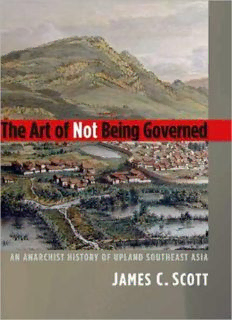
The art of not being governed, an anarchist history of upland Southeast Asia. Yale University Press PDF
Preview The art of not being governed, an anarchist history of upland Southeast Asia. Yale University Press
The Art of Not Being Governed An Anarchist History of Upland Southeast Asia James C. Scott Yale University Press New HaveN & LoNdoN Yale Agrarian Studies Series James C. Scott, series editor The Agrarian Studies Series at Yale University Press seeks to publish outstanding and original interdisciplinary work on agriculture and rural society—for any period, in any location. Works of daring that question existing paradigms and fill abstract categories with the lived-experience of rural people are especially encouraged. —James C. sCott, Series Editor Published with assistance from the Mary Cady Tew Memorial Fund. Copyright © 2009 by Yale University. All rights reserved. This book may not be reproduced, in whole or in part, including illustrations, in any form (beyond that copying permitted by Sections 107 and 108 of the U.S. Copyright Law and except by reviewers for the public press), without written permission from the publishers. Designed by James J. Johnson and set in Ehrhardt type by Tseng Information Systems, Inc. Printed in the United States of America. Library of Congress Cataloging-in-Publication Data Scott, James C. The art of not being governed : an anarchist history of upland Southeast Asia / James C. Scott. p. cm. Includes bibliographical references and index. isbN 978-0-300-15228-9 (cloth : alk. paper) 1. Ethnology—Southeast Asia. 2. Peasantry— Southeast Asia—Political activity. 3. Southeast Asia—Politics and government—1945–. 4. Southeast Asia—Rural conditions. I. Title. ds523.3.s36 2009 305.800959—dc22 2009003004 A catalogue record for this book is available from the British Library. This paper meets the requirements of aNsi/Niso Z39.48-1992 (Permanence of Paper). 10 9 8 7 6 5 4 3 2 1 It is said that the history of peoples who have a history is the history of class struggle. It might be said with at least as much truthfulness, that the history of peoples without history is a history of their struggle against the state. —Pierre Clastres, La société contre l’état This page intentionally left blank Contents Preface ix 1. Hills, Valleys, and States: An Introduction to Zomia 1 2. State Space: Zones of Governance and Appropriation 40 3. Concentrating Manpower and Grain: Slavery and Irrigated Rice 64 4. Civilization and the Unruly 98 5. Keeping the State at a Distance: The Peopling of the Hills 127 6. State Evasion, State Prevention: The Culture and Agriculture of Escape 178 61/2. Orality, Writing, and Texts 220 7. Ethnogenesis: A Radical Constructionist Case 238 8. Prophets of Renewal 283 9. Conclusion 324 Notes 339 Glossary 407 Index 415 This page intentionally left blank Preface Zomia is a new name for virtually all the lands at altitudes above roughly three hundred meters all the way from the Central Highlands of Vietnam to northeastern India and traversing five Southeast Asian nations (Vietnam, Cambodia, Laos, Thailand, and Burma) and four provinces of China (Yun- nan, Guizhou, Guangxi, and parts of Sichuan). It is an expanse of 2.5 million square kilometers containing about one hundred million minority peoples of truly bewildering ethnic and linguistic variety. Geographically, it is also known as the Southeast Asian mainland massif. Since this huge area is at the periphery of nine states and at the center of none, since it also bestrides the usual regional designations (Southeast Asia, East Asia, South Asia), and since what makes it interesting is its ecological variety as well as its relation to states, it represents a novel object of study, a kind of transnational Appala- chia, and a new way to think of area studies. My thesis is simple, suggestive, and controversial. Zomia is the largest remaining region of the world whose peoples have not yet been fully incor- porated into nation-states. Its days are numbered. Not so very long ago, how- ever, such self-governing peoples were the great majority of humankind. Today, they are seen from the valley kingdoms as “our living ancestors,” “what we were like before we discovered wet-rice cultivation, Buddhism, and civilization.” On the contrary, I argue that hill peoples are best under- stood as runaway, fugitive, maroon communities who have, over the course of two millennia, been fleeing the oppressions of state-making projects in the valleys—slavery, conscription, taxes, corvée labor, epidemics, and warfare.
Description: